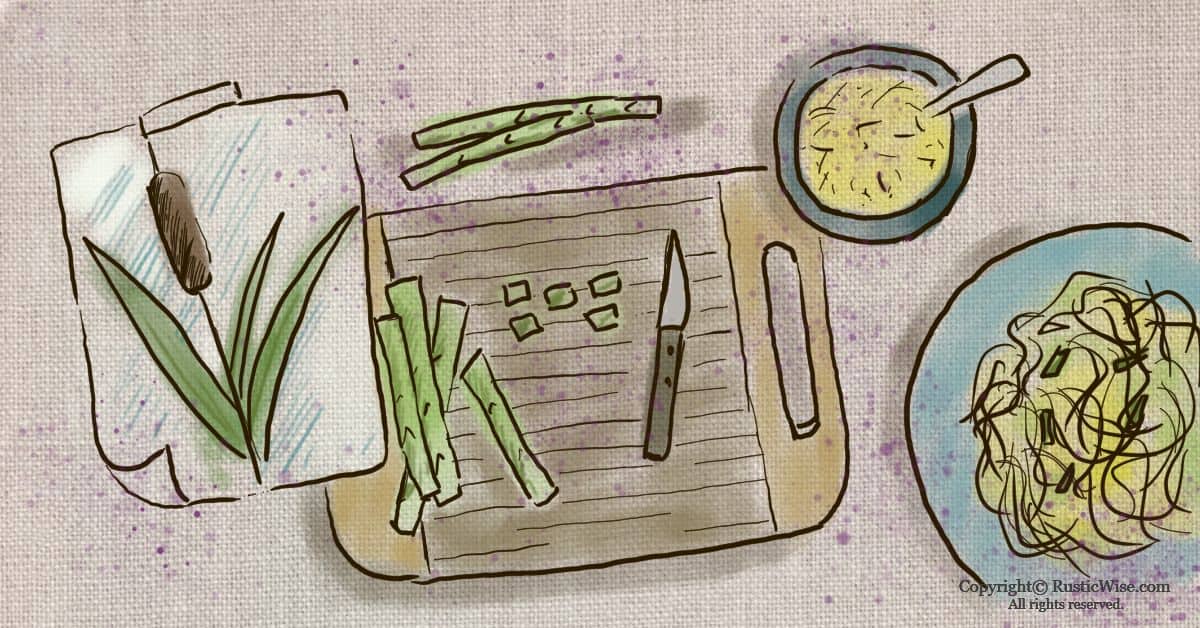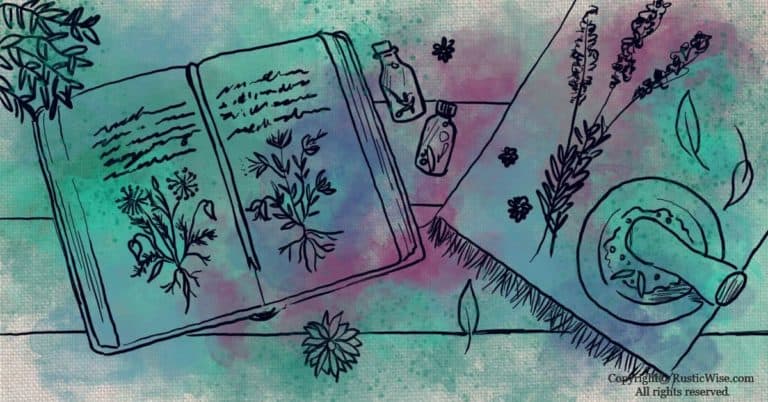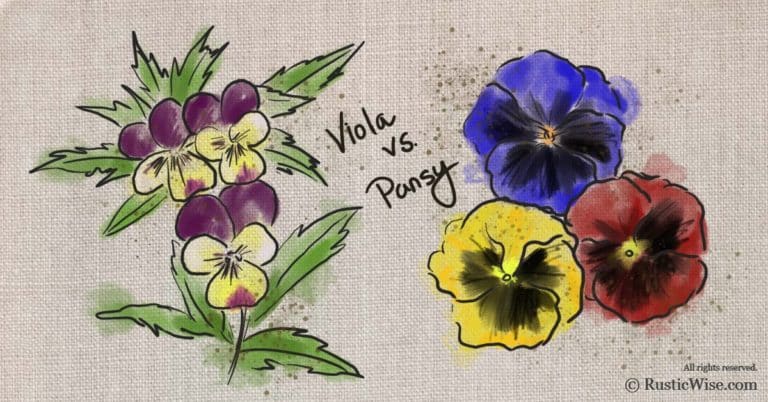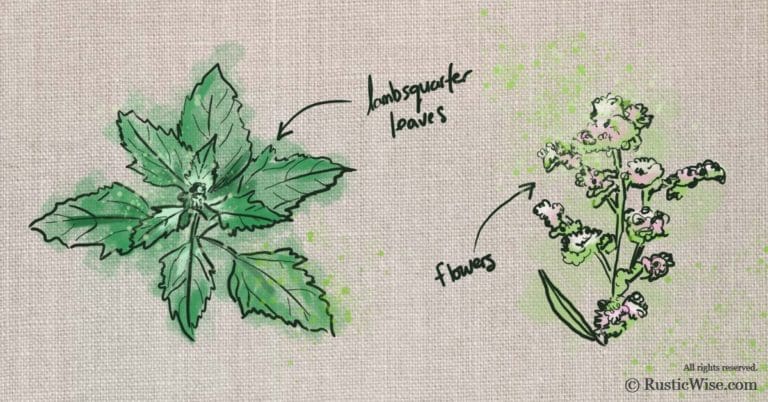Foraging: How to Eat the Cattail Plant + 5 Tasty Cattail Recipes
Cattails are abundant in wetlands such as marshes, ponds, lakes, and meadows. Most of us just think of them as part of the landscape, another plant dotting the shoreline. It’s time to look at cattails in a new light. They are a valuable source of edible wild food full of starch and energy—good to know if you ever find yourself in a sticky survival situation. Curious about how to eat the cattail plant?
The two common types of cattail found throughout North America are southern cattail (Typha domingensis) and broad-leaved cattail (Typha latifolia L.). The broad-leaved cattail is the most common which is why it also goes by common cattail, broadleaf cattail,cat o’nine tails, Cossack asparagus, or bulrushes.
Both the southern cattail and broadleaf cattail are edible. According to the USDA, “all parts of the cattail are edible when gathered at the appropriate stage of growth.”
Indigenous people have used various parts of the cattail plant as a food source. The young shoots were eaten cooked or raw. Rhizomes (the underwater stem from which new leaves and stems grow) were either cooked and eaten like a potato, or dried up to be used as flour. Other parts of the plant were used for practical purposes: leaves were woven as mats, and the soft pollen was used as padding.
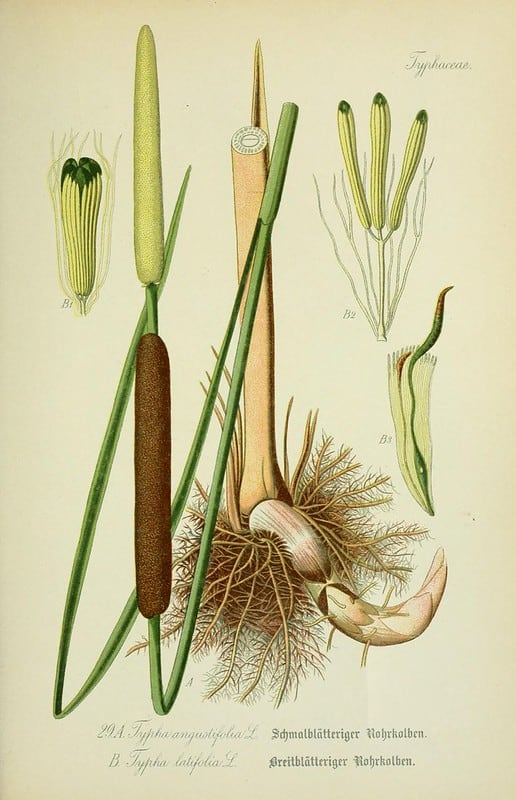
How to eat the cattail plant: cattail edible parts
So what parts of the cattail are edible? And what does cattail taste like? Let’s take a closer look.
Cattail pollen: Used as a flour alternative. It’s naturally a vibrant yellow or green color which adds a splash of color to your baked goods. It has a slightly nutty, earthy flavor.
Brown fuzz: Make your own chewing gum when you combine the cattail’s brown fuzz with tallow (rendered fat).
Young cattail shoots: Eaten raw or cooked. When eaten raw, they have a similar taste to cucumbers—try pickling them. It’s best to consume raw cattail in springtime, and cook them if you’re harvesting later in the year as they tend to get more fibrous. Some say young cattail shoots have an asparagus-taste (which explains its other name Cossack asparagus). When steamed, they have a cabbage-like flavor.
Flower stalks (flower heads): When the outer sheath is removed, the inside can be steamed or boiled similar to corn-on-the-cob.
Rhizomes (the underwater stem portion): The rhizomes have a slightly sweet flavor and are very versatile. The lower portion of each stem along with the rhizome can be treated like a potato and lends itself well to roasting, boiling, baking, and can even be consumed raw. The inner rhizome is a flour substitute when dried and ground up. The rhizome is high in starch with a bit of protein as well. Generally harvested in fall or winter.
Foraging tips for cattails
Cattails aren’t something you’ll find readily at the grocery store, or even the farmers market, so you’ll need to go foraging.
A note of caution before you start foraging for cattails: cattails grow in and around water, it’s vital that the water source is clean. Sometimes cattails are used to restore wetlands and other waterways. The water may be filled with chemicals, or contain runoff from agricultural land. You certainly don’t want to be picking cattails from contaminated water. It’s a good idea to familiarize yourself with the area before you go foraging.
Also, make sure the area is not a protected wetland. Some areas are designated protected wetlands which would make any foraging of plants against local bylaws.
Please use caution when foraging for cattails to ensure the area is free of chemicals and pesticides, and take the time to properly identify the plant before harvesting.
What you’ll need:
- A tall pair of rubber boots (areas that grow cattails are often wet and muddy!)
- A few large garbage bags
- A pair of work gloves to protect your hands
- Appropriate clothing to protect your head and body from the elements such as a wide-brimmed hat and long-sleeved shirt
- Insect repellent (optional)
If you are only harvesting shoots, cut young shoots in spring and summer from the rhizomes when they are between 4-16 inches (10-41 centimeters) tall. Otherwise, you can harvest the entire plant.
The book Foraged Flavor by Tama Matsuoka Wong and Eddy Leroux is a great resource for anyone looking to jump into the world of foraging. It has some helpful tips for foraging cattails:
- There are many shoots growing side-by side from waterways. Look for the characteristic brown fruit (like a corn-on-the cob), fuzzy seed heads, and slightly mottled brown and cream colored tops. Find the brown fruit at the top (or fuzzy remnants of one) and follow it all the way down to the bottom to ensure you’re picking the right plant.
- Find a decent-sized cattail roughly the size of a broom handle at the base.
- With a firm two-handed grip just above the waterline, wiggle it a bit before pulling it out. It should make a splooshing sound like that of a boot becoming unstuck in mud. The shoots are big and white.
- Place the entire plant in a plastic garbage bag.
- It’s best if you are planning to use the cattail right away. Otherwise, you can use either clean towels or plastic wrap around the tops of the plants, and wrap string around to keep them together. Place the roots in a large bucket filled with water in a cool, dark place such as a basement.
To prepare the cattail plant, separate the fruit, stem, leaves, and rhizomes. Wash the stem, leaves, and rhizomes thoroughly.
How to collect cattail pollen
If you want to collect cattail pollen, I found a few helpful tips from Honest Food which I’ve summarized here:
There’s a small window of time each year in which to collect pollen, so keep an eye out.
It’s time to collect pollen when the cattails are slightly green and just starting to turn brown. Find a cattail that’s beginning to show a fuzzy yellow bit just above the tail. Gently bend the cattail over and place it inside a jar or container. Shake the pollen into the jar. You should get around 1 tablespoon of pollen per cattail.
Once you’re at home, use a flour sifter to sort through the pollen to remove any bits you don’t want (such as small critters!).
There’s a small window of time each year in which to collect pollen, so keep an eye on your local cattails.
(Keep scrolling below for Honest Food’s spaghetti with cattail pollen recipe.)
Cattail recipes
While cooking cattails might seem strange at first, there are many (tasty) ways to use the different parts of cattail. Here’s a roundup of five cattail recipes. Have fun and get creative!
1. Cattail Pollen Spaghetti with Wild “Oregano”
The cattail pollen adds a bright yellow color and slightly nutty flavor to this tasty spaghetti meal (via Honest Food).
2. Cattail Shoots in Cream Sauce
A creamy springtime delight showcasing the delicate flavor of young cattail shoots (via My Untangled Life).
3. Cattail Stalk Hot Dill Pickles
Turn tender cattail stalks into hot dill pickles (via Real Tree).
An easy and tasty way to use cattail shoots (via Survival Sullivan).
👉 If you like this post, see our Timeless Guide To Foraging for Wild Food. 🌿
Would you like more timeless tips via email?
Fun tips to help you live an independent, self-sustaining lifestyle. Opt-out at any time.


References:
- USDA Plant Guide, Broad-Leaved Cattail, https://plants.usda.gov/plantguide/pdf/cs_tyla.pdf. Accessed August 2020.
- Utah State University Extension, Range Plants of Utah, Broadleaf Cattail, https://extension.usu.edu/rangeplants/grasses-and-grasslikes/broadleaf-cattail. Accessed August 2020.
- Texas A & M AgriLife Extension, AquaPlant, Glossary, https://aquaplant.tamu.edu/glossary/. Accessed August 2020.
- Matsuoka Wong, Tama and Eddy Leroux (2012). Foraged Flavor. Clarkson Potter Publishers. ISBN: 978-0-307-95661-3.

Author: Josh Tesolin
Josh is co-founder of RusticWise. When he’s not tinkering in the garden, or fixing something around the house, you can find him working on a vast array of random side projects.

